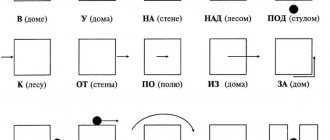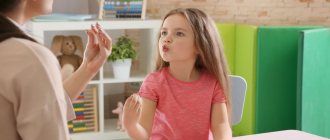Automation of the sound “R” in texts using mnemonic tracks is carried out after the sound is automated in syllables, words, phrases, sentences, and tongue twisters.
Here you can also find poems for automating the sound “R”, a game exercise “Snails”, a set of classes (the complex includes 9 full-fledged lessons with visual material).
You can recite texts and memorize poems at the same time. These two types of lessons on automating the sound “R” are final.
After them, differentiation (discrimination) of mixed sounds begins. In this case, these are the sounds “R” - “L”. They are most often mixed and confused by kids.
Games and exercises for differentiating sounds can be found at the dedicated link.
Automation of the sound P in texts using mnemonic tracks will help:
- Teach your child to pronounce the sound “R” in a coherent text, and therefore in colloquial speech.
- Using mnemonics will develop associative thinking, memory, and attention in children. They will need to match each word with a picture and name it.
- With the help of preposition models, the child will learn to see and hear this “small” word. Children very often connect prepositions with nouns and consider them to be one word (for example, a combination of words ON the table , kids perceive them as one word DESK, etc.). Models of prepositions are presented below.
- With the help of mnemonic tracks, the child will learn to correctly compose sentences and stories. This skill will also be useful in the future when studying at school, because... will teach the child to think figuratively.
Preposition models:
The texts are made in two versions to choose from:
- The first option is signed for the convenience of adults. Tex goes immediately below the picture path. It is designed for individual work with children who cannot read.
- The second version of text mnemonic tracks contains only chains of connected pictures. The pictures are larger in size. There is no signed text in the second version so as not to distract reading children. With the second option, you can work both individually and with a subgroup of children. In this case, the text of the story must be printed separately or on the reverse side.
Print the presented pictures on A4 sheets. It is advisable to laminate them, then they will serve you much longer and enjoy doing them.
Or study online on our website.
Texts for sound automation R:
At a construction site
Fedor gets up with the first roosters. Dresses quickly. Need to go to a construction site. There is tea in the thermos. But Fedor doesn’t drink it in the morning. He takes out kefir and pours in sugar. In the morning, kefir is refreshing. He puts on his jacket and goes out into the yard. Gets on a motorcycle. He starts the engine and drives to the construction site. The work morning begins.
In the garden
Roma and Tamara have a vegetable garden. In the garden beds, red tomatoes, colorful peppers, crispy cucumbers are ripening, sugar snap peas are blooming, and curly parsley is growing. Roma and Tamara are loosening the beds and fertilizing them. The harvest will be good!
In zoo
Yesterday Roma and Raya were at the zoo. There they saw many different animals and birds. Roma especially liked the tigers and panthers, and Raya especially liked the colorful zebras and giraffes. Roma and Raya asked the guide where these animals live and what they are fed at the zoo.
We fed the birds
It was bitterly cold. Vera and Ira went outside. Vera attached a piece of lard to the birch branches. The branch swayed. These were sparrows, titmice, and red-breasted bullfinches. Then the red bullfinch flew off to the side. He only eats grains and seeds. Ira ran up to the tree and scattered a handful of seeds. The birds were happy. The children fed the birds all winter!
Friend
Yegor has a friend. His name is Artyom Dronov. Egor has been friends with him since first grade. Together Egor and Artyom do homework, play football and computer games.
One day Yegor caught a cold. The doctor prescribed him to drink cough medicine. Egor was lying in bed at home, and Artyom bought the medicine at the pharmacy. All week Artem visited his friend and told him school news.
Yura and Raya
Yura has a rocket. Raya has rackets. In the morning Yura and Raya play with a rocket. Yura rules the rocket, and Raya controls the game. Then they go into the yard and play badminton with Raine's rackets. Yura and Raya love to play with each other.
Cockroach's dream
Roma has a hole in his pocket. Roma stuffs his pocket with food. The cockroach follows Roma and picks up crackers, bagels, fruits and cake crumbs. Today the cockroach will invite his friends to visit, and they will have a huge feast. A hole in a slob's pocket is every cockroach's dream
Games and exercises for sound automation [R] for teenagers and adults
Abstract: The article presents ways to automate the sonorous sound [P] in adolescents and adults. Techniques that help quickly consolidate sound in speech are described in detail. The presented materials are suitable for interesting correction for schoolchildren and adults.
Key words: games, techniques, exercises, adults, teenagers.
Abstract:The article presents methods for automating the sonor sound “P” in adolescents and adults. The techniques that contribute to the quick consolidation of sound in speech are described in detail. The presented materials are suitable for interesting correction of schoolchildren and adults.
Keywords: games, techniques, exercises, adults, adolescents.
Along with a large number of children who have speech disorders, there are also older people who, at a minimum, have a violation of sound pronunciation.
The causes of speech pathology can be:
- untimely correction provided by specialists;
- bilingualism (bilingualism);
- hereditary factor;
- social environment;
- injuries of various types, etc.
A mild form of speech impairment is the absence of any single sound in speech, the replacement of a sound or its distorted pronunciation. A common occurrence of sound pronunciation disorders in adolescents and adults is rhoticism .
Basically, every person in his life has encountered burry people, and, recently, burr has become the norm on television.
People with rhoticism are divided into two categories, where for the first group of people this disorder is not a disadvantage, but on the contrary serves as a certain feature, a “highlight” in their speech abilities.
But despite the fashion, the “French accent” that society dictates to us, there is a category of teenagers and adults for whom being burry is a significant drawback that leads to complexes.
Given their speech imperfections, such people are embarrassed when communicating with peers, colleagues, classmates, they feel and hear ridicule from others.
Considering this psychological pressure from society, they also develop fears in public speaking and a reluctance to engage in dialogue with unfamiliar people.
Not many people are ready to overcome this psychological barrier; some go to trainings related to the emancipation of their personality, while others turn to specialists in eliminating speech deficiencies - speech therapists.
Working with people of the older age category, the speech therapist builds a program and step-by-step work, as with young children.
Table 1. Stages of work on sound production and automation [P]
| № | Stages | |
| 1. | Development of motor skills of the articulatory apparatus; development of physiological and speech breathing (if necessary); | Performing articulatory and breathing (if necessary) gymnastics. Particular attention is paid to the following exercises: “Drum”, “Mushroom”, “Chatterbox”, “Turkey”. |
| 2. | Sound production through a combination of TR and DR | The correct pronunciation of the sound is shown and explained. The articulatory structure of the organs of the speech apparatus is shown when pronouncing the required sound. |
| 3. | Automation of TR and DR sounds at the beginning, in the middle and at the end of words. | TR (DR) grass, mattress, liter TR (DR) cable, sailor, inspection Tru (DR) coward, girlfriend TR (DR) ... TR (DR) Materials are used from speech therapy notebooks: Azova E.A.; Zhikhoreva Yu.B. and other authors. |
| 4. | Staging a pure isolated sound P | The correct pronunciation of the sound is shown and explained. The articulatory structure of the organs of the speech apparatus is shown when pronouncing the required sound. |
| 5. | Automation of the R sound at the beginning, middle and end of words. | RA, RO, RU, RY; AR, OR, UR, YR, ARA, ORO, URU, YRY, etc. Rocket, Cow, Frost, Tiger, ... Materials are used from speech therapy notebooks: Azova E.A.; Zhikhoreva Yu.B. and other authors. |
| 6. | Differentiation R-L | Ra-la, lo-ro, lar, roll, …. |
| 7. | Setting a soft sound R. | RYA, RYO, RYU, RI, RE |
| 8. | Automation of the soft R sound at the beginning, middle and end of words. | Rice, baby, cream, sailor, gingerbread, etc. |
| 9. | Differentiation P-PbDifferentiation P-L | Materials from speech therapy notebooks are used: Azova E.A.; Zhikhoreva Yu.B. and other authors. |
| 10. | Automation of assigned sounds in independent speech. |
Any work with sounds begins with the correct production of this sound .
The student is shown the correct articulation pattern, then with the help of gymnastics the muscles of the face, lips, tongue, palate, etc. are trained.
There are many different techniques that describe ways to produce the sound R. All of them are effective in their own way, but depending on a person’s articulatory abilities, the period of production can vary from the first day of classes to several months.
One of the effective ways to produce the sound R is the “MUSHROOM” exercise.
The logopath is offered:
1. Smile2. Open your teeth3. Stick your tongue to the roof of your mouth
4. And in this position, pronounce the sound D and blow strongly on the ends of the tongue, while the tongue should remain in an elevated state.
*This complex is performed by imitation, but to quickly master this skill, you can help the speech therapist with a spatula or probe substitute.
In adults, the process of sound production proceeds faster than in children.
The automation process is much more complex and time-consuming.
At the initial stages, sound automation in adults and adolescents is based on the same principles as in children of preschool or primary school age (see Table 1).
This table shows the stages of production and automation of sounds, but the most important and fundamental process, due to which an adult intends to correct his speech, is the automation of sound in independent speech.
When working with adults who have rhotacism, the main task is to find material where the person has automated a new sound for him as quickly as possible.
The materials that are in teaching aids and author's workbooks are not entirely suitable for teenagers and adults, because... Lightweight, children's material is presented there.
In my article I want to offer those games and exercises that will interest an adult and will help him master a new sound as much as possible.
Games and exercises for sound automation [R]
Match adjectives with the sound R to nouns.
Example:
Wheel (round, trolleybus, durable, ...) Marmalade (apricot, sugar, imported, ...) Kangaroo (fast, jumping, large, ...)
Etc.
Flight of fancy.
Improvisation game.
— For 2 or more players:
Everyone takes turns saying any word with the sound R/Рь, for example:
1st says "eagle", 2nd says "baby", 3rd says "lace", 4th says "lizard", etc.
At the same time, everyone writes down the words. Should be about 7-8 words.
If there are few people, then everyone takes turns calling out more words, thereby getting the required number of words.
Then, for a certain amount of time, everyone comes up with a story, using all the written words, changing them according to cases and numbers.
— For 1 student:
We suggest taking out 7-8 cards (notes) with words from the “Magic Bag”. Say them and, within a certain time, come up with a story using these words.
Unusual verse
Improvisation game.
Distribute cards with a poem (or use a “Magic Bag” from which the student takes out a card with a poem) and announce that they need to read in accordance with the situation written on the back:
1. You have a bad cold and are constantly sneezing; 2. You really want to sleep, you yawn; 3. Beg for alms;4. You are very worried, stutter, embarrassed; 5. You swear
Etc.
Alphabet letters
1. Start a dialogue with your partner on any topic. only each subsequent phrase must begin with the next letter of the alphabet.
For example:
August is ending. It will be autumn! It’s time to get out your felt boots. Mountain skis too! Let’s better get some skates - I’ve always dreamed of learning how to skate on them!
Skiing is more fun! etc.
2. Take one letter and start all your lines with it. Try not to repeat words. In this option, you also need to maintain the dynamics and find the dialogue box.
For example, the letters P and N were chosen.
A. We need to paint the fence! B. I don't want to get my hands dirty. Put on your gloves
B. Rubber?
Excursion
The student is invited to take excursions to some sights. This exercise can be offered at each lesson, but each time changing the topic.
Examples:
— Excursions around the zoo (aviary with tigers) — Excursion to the oceanarium (Coral reefs) — City tour (Moscow) — Metro tour — Excursion to the theater or museum, etc.
- An evening walk
Presentation
This task is used in the marketing field, when interviewing potential employees. Here you need to present the product and try to sell it, you can also present the item as in an auction. There are various items to choose from (washing powder, crown, necklace, carpet, etc.). The speech therapist’s task is to come up with a commercial for the selected item within the allotted time.
Examples:
- Selling exotic fruits. - Presentation of a new computer - Sell a pen/pencil
— Auction of antique wine glasses, etc.
Task
In this task, you need to propose a topic, then the speech therapist talks about his actions to help solve the problem. In this case, you can prepare a dictionary in advance that will be used by the student. Words are thrown in during a monologue.
Examples:
- How to find a shirt that fits in a shopping center? - Which friend would you take to the seaside? - Who would you invite to the theater? - A trip to the country. (vocabulary: crow, fence, turnip, basket, turnip, rowan, prince, ...)
— What gift can you make with your own hands? / Surprise gift. (pink ribbon, box, brooch, trash, ...)
Interview
Ask questions to your student (interlocutor) on a specific topic.
Examples:
A. Did you do well at university? Did you enjoy the internship and how did you remember it? What would you like to do? How would you describe your work?
Where do you see yourself in 10 years?
B. Do you believe in friendship? Tell me about your best friend?
Should you always listen to your friends' advice?
Q. What do you like to do in your free time? Tell us about your favorite hobby. Do you often manage to be alone with yourself? Do you like to read? Watch movies, go to the theater, etc.?
How often do you visit such places?
Story by picture
1. A story based on a series of plot pictures.
Here we can offer both children's pictures and pictures for the older generation. You can even offer comics and try to voice them.
2. Descriptive story based on one picture.
Freeze
Photographs or pictures with interesting images are prepared in advance and asked to describe the emotion or action that is depicted, what contributed to this, and under what circumstances the fragment was captured.
A difficult situation
Talk about your actions.
— You lost the salaries of your subordinates (public money) in a casino. Your actions?
— You were accidentally locked in someone else’s house (at work) late at night. Your actions?
— Your dog ate a very important paper that you must present in court in the morning. Your actions?
- You come home, and an unfamiliar man is sleeping on your bed. Your actions?
— You come to work, and another employee is sitting in your place. Your actions?
— You were invited to a restaurant, you had dinner and suddenly your companion disappears without paying. Your actions?
— You bought hair dye, dyed your hair, and it turned out that it turned green. There is no time to repaint, but you definitely need to go to the gala reception. Your actions?
“You have an important report tomorrow, and your neighbors are having a big party that won’t let you sleep in any case.” Your actions?
An eloquent picture
Number of players: any. Props: task cards - printed images of famous paintings.
Pictures are always silent. But surely many viewers would be interested to know what the drawn characters are thinking or talking about among themselves. Try to “voice” some pictures.
Options for tasks – paintings that players need to “revive”:
- "Mona Lisa" by Leonardo da Vinci
- "Alyonushka" Vasnetsov
- "Judith" Giorgione
- "Penitent Marina Magdalene" by Titian
- "The Seated Demon" by Vrubel
- “Three heroes” by Vasnetsov
- “Hunters at Rest” by Perov, etc.
Players are given a certain time to come up with a monologue (dialogue, conversation).
Sinkwine
A cinquain is a short, unrhymed poem of five lines. There are many varieties of syncwine.
- The first line is the theme of the syncwine, one word, noun or pronoun;
- The second line is two adjectives or participles that describe the properties of the topic;
- The third line is three verbs or gerunds telling about the actions of the topic;
- The fourth line is a four-word sentence expressing the personal attitude of the author of the syncwine to the topic;
- The fifth line is one word (any part of speech) expressing the essence of the topic; a kind of resume.
The result is a short, unrhymed poem that can be devoted to any topic.
Example:
Rainbow Multi-colored, bright Appears, flickers, shimmers Rainbow appears after the rain
Beautiful!
All games can be combined and used in different variations.
When creating the exercises, the basis was improvised games used at various holidays. This processing of the material made it possible to work out the required sound with interest.
Well, for more successful sound development and its automation, the constant task remains to repeat and learn tongue twisters and tongue twisters as often as possible.
Umudkhanova Zariat Saidmagomedovna, speech therapist teacher
( 1 liked, average: 5.00 out of 5) Loading…







